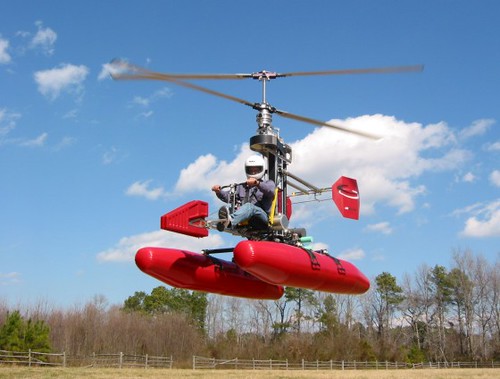While we’re still waiting for flying cars (or even just fuel efficient cars) I’m keeping track of tiny helicopters like the GEN H-4 and this one, the AirScooter II, pictured above.
The company, AirScooter Corporation of Henderson NV, introduces the new craft with a tip of the hat to Igor Sikorsky‘s earliest designs featuring counter-rotating blades. Company founder Woody Norris (who won an award for acoustics) explains: “what we’ve done is package the coaxial design in a modern light-weight craft that allows for intuitive control and incredible maneuverability.”
By eliminating the need and complexity of swashplates, collective and cyclic control through a coaxial rotor design a number of benefits beyond conventional helicopter designs are immediately realized. First; enhanced, intuitive flight controls are achieved by simple motorcycle-style handlebars and the absence of a tail rotor. To gain altitude, simply throttle up like you would on a motorcycle, turn left or right on the handlebars for craft rotation and move the handlebar assembly as a joystick for directional control (including reverse). No pedal controls are necessary, which means someone without the use of their legs can just as easily fly the AirScooter. Handlebar controls represent the most distinguishable feature of the AirScooter. AirScooter’s patented design also provides an amazing level of stability while in the air and during flight.
The AirScooter II is said to meet the requirements of FAR Part 103 and is classified as an ultralight. Would-be flyers need no FAA pilot’s license, just the steel will and faith in engineering.
Powering the personal helicopter is the custom-designed AeroTwin engine. AirScooter called on motorcycle racing engine specialist Bill White of New Zealand to develop an ultralight, 4-stroke engine producing 50-75 horsepower. The resulting two cylinder, air cooled aluminum engine features ceramic coated combustion surfaces, hollow cam shafts, and the option to run it either vertically or horizontally.
Price is expected to be $50,000 when the production model debuts sometime before the end of 2006. Regulations limit it to five gallons of fuel and a max speed of 55 knots (about 63 miles per hour). Useful load maxes out at about 350 pounds. Flight duration is reported as about one hour, and they recommend a ceiling of about 50 feet. Unlike many ultralight aircraft, the AirScooter will be sold fully assembled, and not in kit form (well, just bolt on the 14 foot diameter rotor blades).
The sky is the limit, literally. The AirScooter is not designed or marketed to just be the “next thing” for recreational hobbyists. “Traditional recreational vehicles like ATV’s and jet-skis are fun, but limited in use,” says Dwaine Barnes, President of AirScooter Corporation, “the AirScooter will provide a simple way for man to achieve the excitement and versatility of flight for recreational and professional use that’s beyond any other product on the market.”
update: there’s video!
